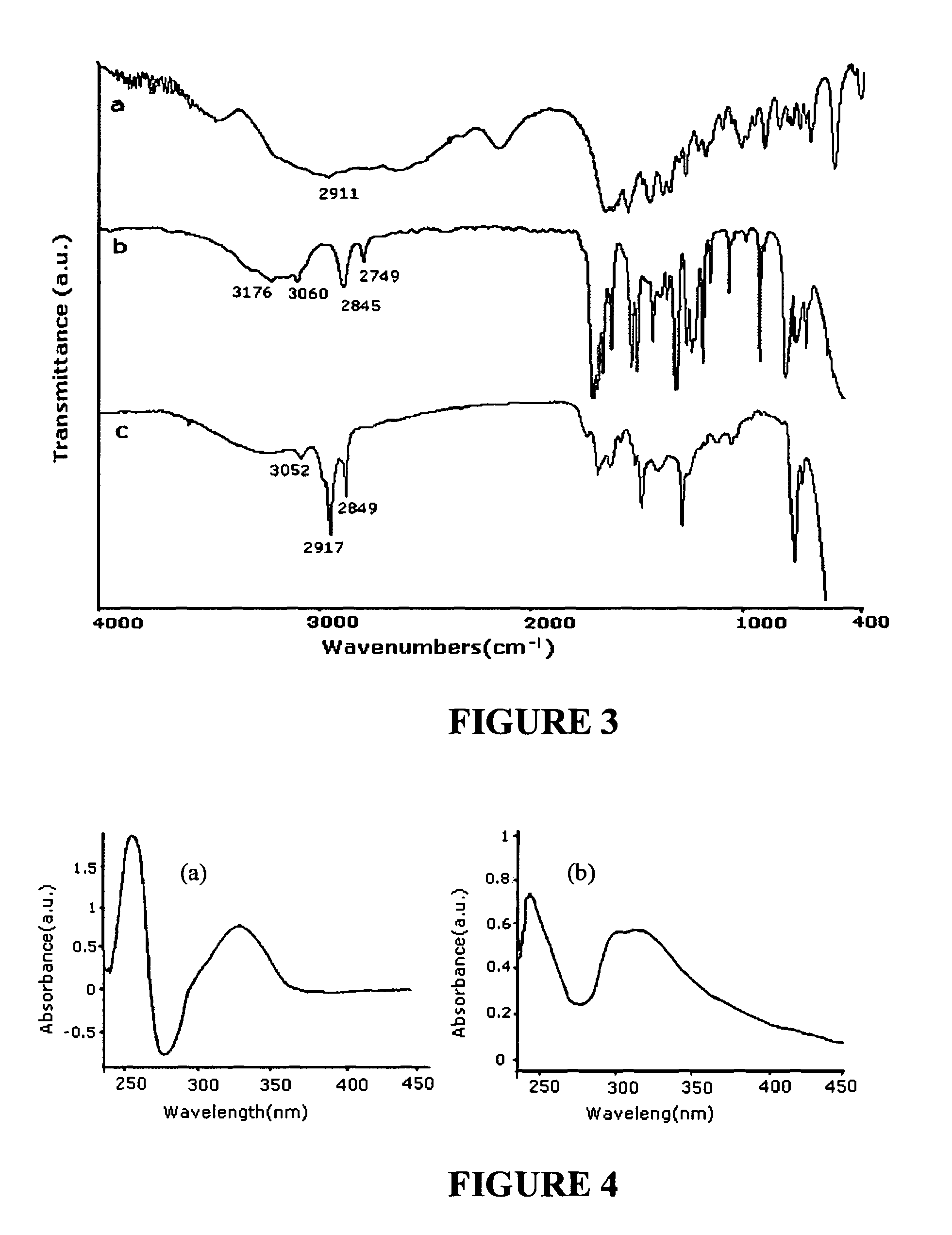Microwave induced functionalization of single wall carbon nanotubes and composites prepared therefrom
a carbon nanotube and functionalization technology, applied in the field of nanomaterials, can solve the problems of limited solubility in common solvents, long process of conventional acid treatment, limited solubility, etc., and achieve the effects of high yield, high purity and rapid funtionalization
- Summary
- Abstract
- Description
- Claims
- Application Information
AI Technical Summary
Benefits of technology
Problems solved by technology
Method used
Image
Examples
example 1
[0100]Experiments were carried out in a CEM model—205 microwave oven. The reaction chamber was of 100 ml volume, lined with Teflon PFA®, and tilted with a 0˜200 PSI pressure controller.
[0101]For the amidation reaction, the first step was the generation of carboxylic acid groups on the SWNTS. In a typical application, 6˜10 mg of pristine SWNTs from Hipco process was loaded into an extraction vessel, along with 20 ml of conc. HNO3 (70%). The microwave power setting was 75% (total of 900 watts), the pressure was set at 125 PSI, and the reaction was carried out for 10˜15 min. After cooling the vessel to room temperature, the reacted mixture was filtered, washed and dried. About 5 mg of this carboxylic acid grafted SWNTs was used to react with 2,6-dinitroaniline. On amidation reaction, 20 ml of DMF was used as the solvent, 15 to 20 mg of amine was added, and all other conditions remained same as before. The reaction was carried out for 15 to 20 min. Once cooled, the mixture was filtered,...
example 2
[0111]This exemplary embodiment shows a method of synthesis of highly, water and alcohol, soluble nanotubes, and in particular, SWNT. The experiment includes utilizing a CEM Model 205 microwave oven with a typically 100 ml or larger closed vessel reaction chamber, lined with Teflon PFA® and fitted with a 0˜200 psi pressure controller. The SWNTs used were prepared by the high pressure HiPCO process.
[0112]In this embodiment, 10 to 20 mg of SWNTs were added to 20 ml of a mixture of 1:1 nitric acid (70%) and sulfuric acid (97%) in the reaction chamber. The reaction vessel was then subjected to microwave radiation. The microwave power was set at 50% of a total of 900 watts, and the pressure was set at 20 psi. The microwave-induced reaction was carried out for 1, 2, 3, 5, 10 and 20 minutes respectively. Three minutes was found to be the optimum reaction time. At this point, the functionalized SWNTs became highly water soluble, and no nanotubes were lost. After the reaction, the reacted mi...
example 3
[0120]This exemplary embodiment shows a method of synthesis of ceramic-SWNT composite. The experiment includes utilizing a CEM Model 205 microwave oven with a typically 100 ml or larger reaction chamber, lined with Teflon PFA® and fitted with a 0˜200 psi pressure controller. The Fourier transform infrared spectroscopy (FTIR) measurements were made either in highly purified KBr pellets (solid sample), or on NaCl crystal window (liquid sample) using a Perkin Elmer instrument. The Raman spectra were obtained using a Renishaw System 1000 Micro-Raman Spectrometer with 785 nm laser as the excitation source. The transmission electron microscope (TEM) images were recorded using a TOPCON 200 kV Ultra-High Resolution Transmission Electron Microscope. The scanning electron microscope (SEM) images and energy dispersive X-ray (EDX) data were obtained using a LEO 1530 instrument. Thin film X-ray diffraction (XRD) data were collected on a Philips X'Pert MRD instrument equipped with an Eulerian Cra...
PUM
| Property | Measurement | Unit |
|---|---|---|
| power | aaaaa | aaaaa |
| temperature | aaaaa | aaaaa |
| volume | aaaaa | aaaaa |
Abstract
Description
Claims
Application Information
 Login to View More
Login to View More - R&D
- Intellectual Property
- Life Sciences
- Materials
- Tech Scout
- Unparalleled Data Quality
- Higher Quality Content
- 60% Fewer Hallucinations
Browse by: Latest US Patents, China's latest patents, Technical Efficacy Thesaurus, Application Domain, Technology Topic, Popular Technical Reports.
© 2025 PatSnap. All rights reserved.Legal|Privacy policy|Modern Slavery Act Transparency Statement|Sitemap|About US| Contact US: help@patsnap.com



